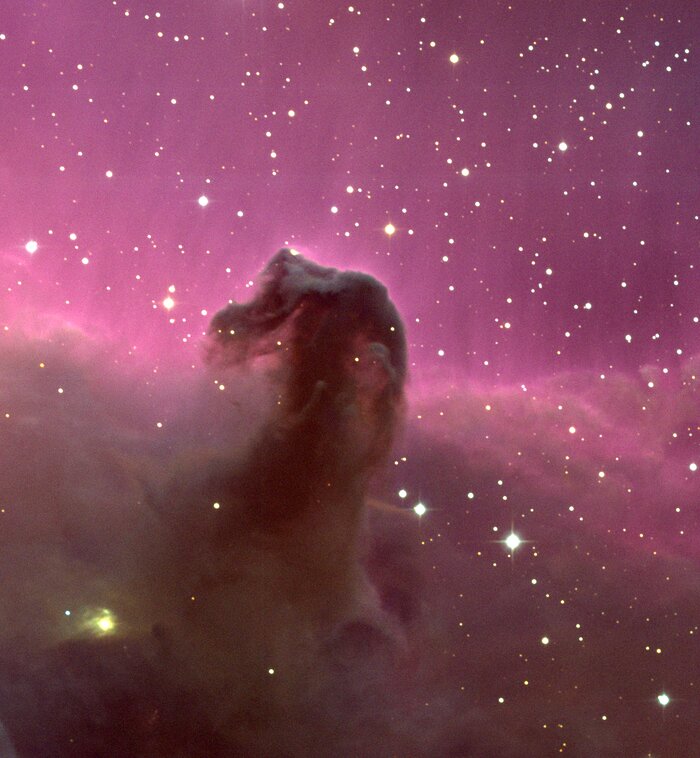The Horsehead Nebula
This color picture was made by combining several exposures taken on the night of December 28th 1994 (UT of observation 29/12/94 around 04:00) with a 2048x2048 CCD detector at the 0.9m telescope of the Kitt Peak National Observatory. Observing conditions were not ideal throughout, and so only a select few of the original observations were used. The final tally used five frames in the B (blue) filter for a total of 22 minutes, three frames with the V (green) filter, 15 minutes, and two with the R (red), total 10 minutes. Each frame was carefully cleaned, a particularly difficult task for the blue filter due to internal reflection problems in the telescope, and then aligned and combined by computer to create this (approximately) true color picture. The pixel size on the sky is 0.68 arc seconds; after combination, the final size is 1480x1366, or about 17x15 arc minutes. Orientation of thumbnail image: N to the left, E down. About this object The Horsehead Nebula, a part of the optical nebula IC434 and also known as Barnard 33, was first recorded in 1888 on a photographic plate taken at the Harvard College Observatory. Its coincidental appearance as the profile of a horse's head and neck has led to its becoming one of the most familiar astronomical objects. It is, in fact, an extremely dense cloud projecting in front of the ionized gas that provides the pink glow so nicely revealed in this picture. We know this not only because the underside of the 'neck' is especially dark, but because it actually casts a shadow on the field to its east (below the 'muzzle'). The marked change in the density of stars visible on either side indicates that the strip of glowing hydrogen marks the edge of a substantial dark cloud. As a cloud core emerging from its parental cloud, and as an active site of low-mass star formation, the Horsehead is a simple system of considerable use for testing models of photodissociation regions, and revealing the intricate interrelations between gas, dust, and the light from hot stars. Polarization maps suggest that the entire region is illuminated by the bright OB star Sigma Orionis, which is also responsible for exciting the emission nebula. (The much brighter Zeta Orionis is a foreground star, not related to the nebulosity.) The 'streamers' visible in the brighter region appear to be due to a magnetic field which leaves the Horsehead cloud approximately radially, having been entrained by outflowing matter. Small red spots in the base of the Horsehead betray the presence of hidden protostars, and red streaks near the yellowish nebula surrounding V615 Orionis (bottom left) are Herbig-Haro objects, which are jets of material ejected from protostars. The Horsehead is a fascinating, active, and complex neighborhood. Location: 05 38 27 -02 29 (1950.0), constellation of Orion. Distance: about 1600 light-years.
Créditos:About the Image
| Id: | noao-02188 |
| Tipo: | Observation |
| Release date: | 30 de Junio de 2020 a las 21:34 |
| Size: | 1366 x 1480 px |
Sobre el Objeto
| Nombre: | Horsehead Nebula |
| Constellation: | Orion |
| Categoría: | Nebulae |
Fondos de Pantalla
Coordenadas
| Posición (AR): | 5 41 14.51 |
| Posición (Dec): | -2° 30' 16.91" |
| Campo visual: | 15.49 x 16.78 arcminutes |
| Orientación: | North is 90.2° left of vertical |
Colores y Filtros
| Banda | Telescopio |
|---|---|
| Optical B | WIYN 0.9-meter Telescope |
| Optical V | WIYN 0.9-meter Telescope |
| Optical R | WIYN 0.9-meter Telescope |

